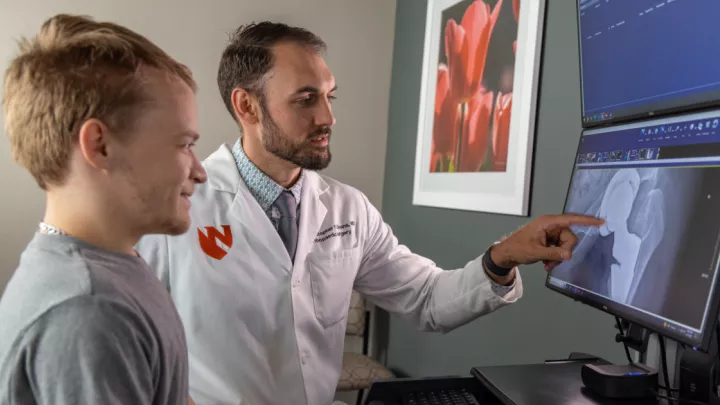When do you need a shoulder replacement?

Like a hip or knee, there may come a point in your life where you consider whether you need a shoulder replacement. Thanks to advances in implant design and surgical techniques, the longevity of shoulder replacements has recently increased. That's why shoulder replacement surgeries are among the fastest-growing joint replacement procedures.
Even with improvements in shoulder arthroplasty, it's vital to ensure you absolutely need a shoulder replacement before receiving the procedure. "These replacement joints are metal and plastic, so they don't last forever," says orthopaedic surgeon Richard Amendola, MD.
When shoulder replacement surgery is necessary
According to Dr. Amendola, the two primary reasons patients need shoulder replacement surgery are end-stage arthritis and rotator cuff arthropathy. Both conditions can reach a tipping point when they become too painful or stiff. "The main signs you may need shoulder replacement surgery are pain and loss of motion," says Dr. Amendola. "And if you have a deficient rotator cuff, weakness is usually a big part too.”
Because pain is subjective, everyone's pain threshold for shoulder arthroplasty will differ. "It's up to the patient to decide when they can't deal with their pain anymore," says Dr. Amendola. "So, when we do surgery, it is based on each person's expectations, what they do daily and how old they are.”
Before opting for shoulder replacement surgery, most providers will encourage patients to try nonsurgical interventions. These treatments include:
- Rest
- Activity modification (trying not to do things that make your shoulder hurt)
- Physical therapy (getting stronger and more flexible)
- Steroid injections
Although steroid injections can help, Dr. Amendola advises against repeated use. "A steroid injection is always reasonable to try, but they lose their efficacy the more you use them. So, usually, I'd recommend only one or two because they won't last as long each time.”
Pre-shoulder replacement surgery steps
Once you've exhausted these nonsurgical interventions, or your pain is too extreme, a shoulder replacement surgery is a patient's next step. "In general, when you decide you want a shoulder replacement, we can usually schedule it within a couple of weeks or months," says Dr. Amendola.
“First, we'll get a CT scan of the shoulder and then plan the surgery using special software," says Dr. Amendola. "Through this program, we can manipulate the implants in three dimensions, figure out the best size and position and debate what kind of implant to use.”
Types of shoulder replacement surgery
There are two primary forms of shoulder replacement surgery: an anatomic total shoulder replacement and a reverse total shoulder replacement.
An anatomic total shoulder replacement surgery is when doctors replace the ball and socket with a metal ball and plastic socket, respectively. "An anatomic total shoulder replacement is typically for younger patients (under 70) and only works if you have an intact rotator cuff, " says Dr. Amendola.
Patients with a torn or severely damaged rotator cuff can opt for reverse total shoulder replacement. "In a reverse total shoulder surgery, we put a ball where the socket is and a socket where the ball was," says Dr. Amendola. "Reversing these parts of the joint changes the mechanics of the shoulder to use the deltoid – the big muscle on the side of your shoulder – to lift your shoulder and move it more efficiently to compensate for when you don't have a rotator cuff.”
Each of these surgical styles also necessitates different recovery timelines. With an anatomic total shoulder replacement, "I would say the first six weeks you're slower moving because we're babying the repair of the rotator cuff muscle," says Dr. Amendola. In an anatomic total shoulder procedure, the surgeon must take down your front rotator cuff muscle to access the shoulder and then put that muscle back.
“So, an anatomic total shoulder replacement takes more time to heal," says Dr. Amendola. "Still, after those first six weeks, your recovery speeds up, and I would say you're probably 80% to 90% recovered at three or four months. But I encourage patients that they can and should improve for up to 12 months after surgery.”
On the other hand, a reverse total shoulder replacement is typically easier to recover from because you're not waiting for the rotator cuff to heal. "I would say the first six to eight weeks go a little faster for a reverse total shoulder procedure," says Dr. Amendola.
Although the recovery from a reverse total shoulder replacement is faster than an anatomic total shoulder replacement, the anatomic total shoulder surgery, if everything goes well, will give you a more normal-feeling, natural shoulder, according to Dr. Amendola.
“Whereas with the reverse total shoulder, you're getting something that will get you from point A to point B, but you'll probably lose some range of motion and internal rotation," says Dr. Amendola. "For example, it might be hard for you to reach behind your back. But this surgery does the trick, and its primary positive is that you don't need a rotator cuff for the reverse total shoulder arthroplasty.”
Shoulder replacement surgery at Nebraska Medicine
Any shoulder replacement is a significant surgery, and there can be complications. "So, I really stress with patients that even if their X-rays or MRIs show they're a candidate for a shoulder replacement, it's still an elective surgery," says Dr. Amendola. "And it's up to you to decide when you want to go through with it.”







